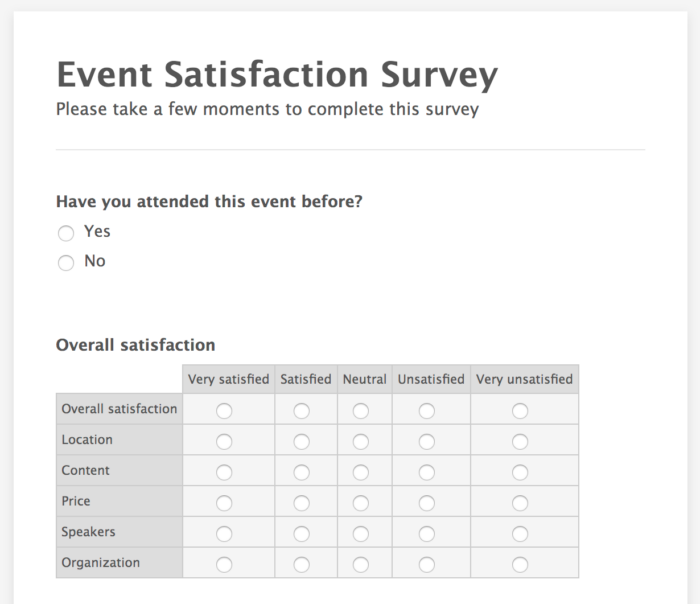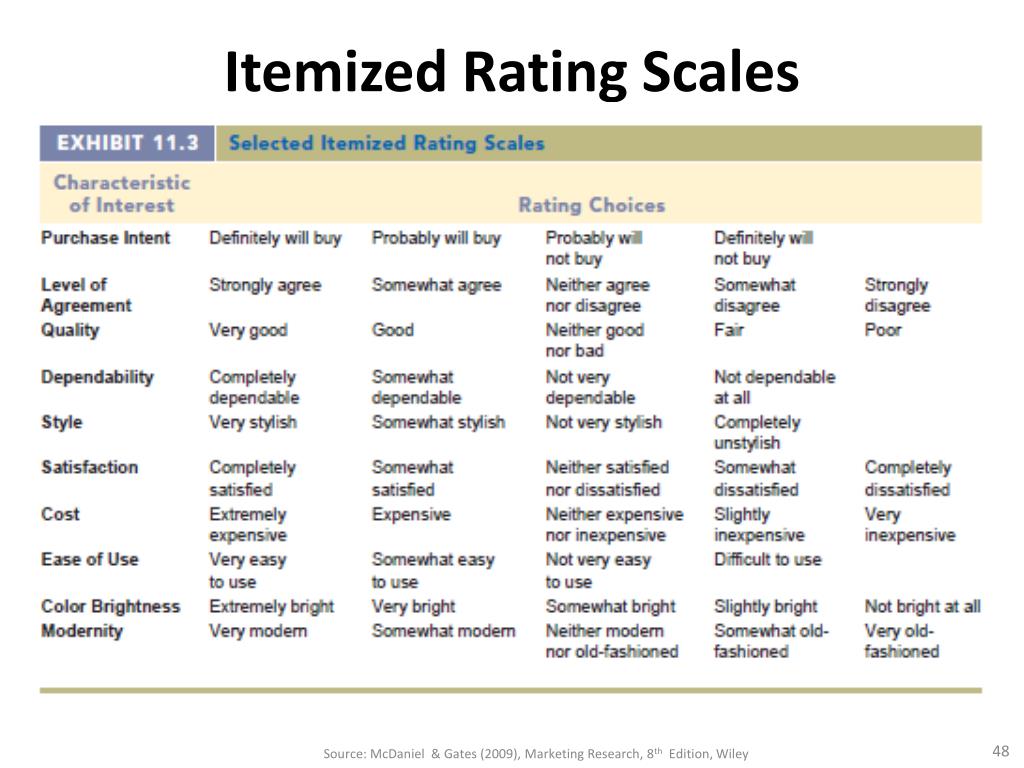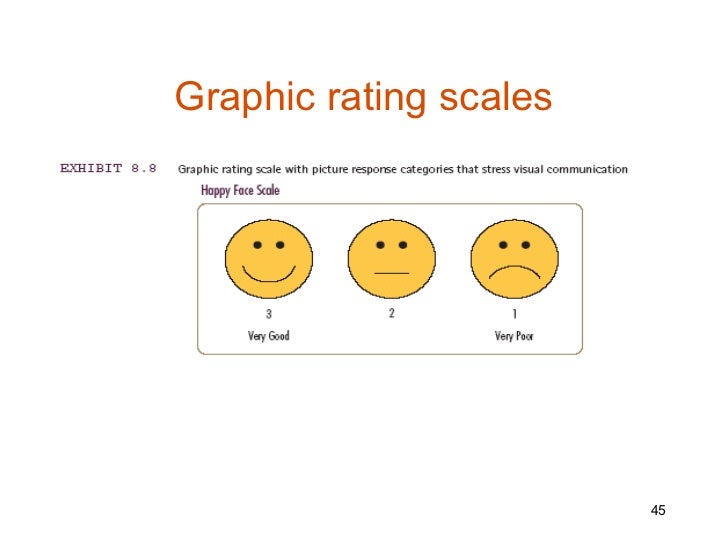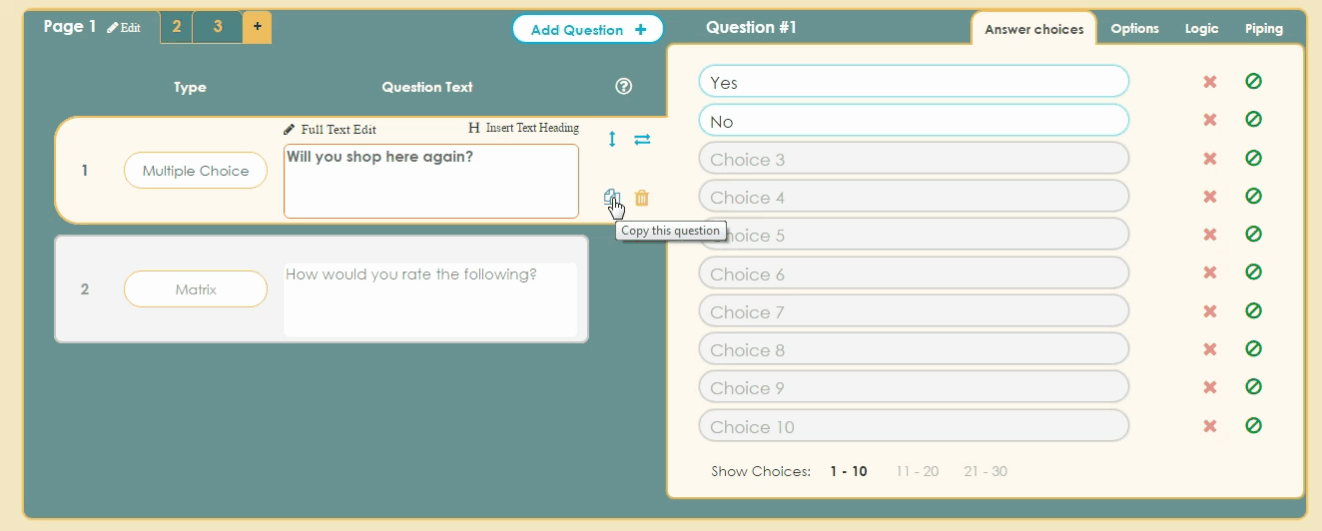40 survey rating scale labels
Sample Likert Scales // Division of Student Affairs ... 2 - Rarely, in less than 10% of the chances when I could have. 3 - Occasionally, in about 30% of the. chances when I could have. 4 - Sometimes, in about 50% of the chances when I could have. 5 - Frequently, in about 70% of the. chances when I could have. 6 - Usually, in about 90% of the chances I could have. Likert Scale Definitions and Examples. Use them for free. Jul 09, 2019 · The size of a Likert scale may vary, but scales with odd numbers of points prevail as they can have a midpoint (neutral answer). An even number of labels, as in a 4-point or 6-point Likert scale, make respondents choose strictly between “for” or “against”. Most commonly, survey specialists use a 5-point scale (see examples A, B, D).
Survey Questions: 100 great question examples and 15 types Jan 10, 2022 · 4. Rating Scale Questions. Also called ordinal questions, these questions help researchers measure the opinions and attitudes of consumers in a quantitative way. This type of question comes with a range of response options. It could be from 1 to 5 or 1 to 10. In a survey, a respondent selects the number that accurately represents their response.
Survey rating scale labels
How to Label Response Scale Points in Your Survey | Qualtrics But how exactly should you label them? Unfortunately, few researchers give their scale labels much thought, let alone seek out best practices recommended by survey methodologists. Here are two examples of response scales that, on the surface, may seem equally viable: 1. 2. PDF Typical Survey Response Scales - STLHE n Bipolar scales (Disagree to Agree) have a maximum reliability and validity at 7 points whereas unipolar scales (e.g., Not True at all to Completely True) have a maximum reliability and validity at 5 points (Krosnick & Fabrigar, 2003) n Numeric labels seem to increase confusion rather than verbal labels (Krosnick & Fabrigar, 2003) Survey Response Scales: How to Choose the Right One | CXL Survey response scales can be embedded in the survey (e.g., 1-5, 1-10, etc.), chosen via a drop-down menu, or included as part of the survey language. No matter how you choose to display the scale, the default ranges affect the precision of your data. For example, if a survey asks your age, a default range of 20-25 instead of 20-30 has ...
Survey rating scale labels. Three Tips for Effectively Designing Rating Scales ... Labels are key to avoiding ambiguity and respondent confusion. This means that partially labeled scales may not perform as well as a fully labeled scale and that numbers should only be used for scales collecting numeric data (not rating scales). Fully labeled scales have been shown to produce more reliable and valid data 6. Krosnick & Fabrigar ... Rating Scales lists and examples from HR-Survey.com Rating Scales used in Survey questionnaires. Many examples to choose from. Scales measuring: satisfaction, agreement, frequency, importance, and quality. 1-to-10 Rating Scale Survey Template 🚀 Survicate 1-to-10 Rating Scale Survey Template 🚀 Survicate 1-to-10 rating scale survey template Send this survey for free Interact with the survey template to see how it works: No time limit on the free plan Set up in minutes No credit card required Find out what your customers think of you with our 1-to-10 rating scale survey template. Satisfaction Surveys and Questionnaire Rating Scales To design a rating scale question for your satisfaction survey, you must consider: 1. What aspects of the product or service to measure. 2. What measurement scale to use: Level of Satisfaction. How well the product or service meets expectations. How good or bad the product or service is. Level of Importance.
Choice of rating scale labels: implication for minimizing ... Loading the rating scale with more positive labels appears to be a useful strategy for reducing the ceiling effect and increases the discrimination ability of survey responses. Conclusions: The current research provides a survey design strategy to minimize ceiling effects. PDF Design of Rating Scales in Questionnaires Balanced rating scales are symmetrical, that is, they have the same number of positive and negative categories. Third, the verbal labels should be generally comprehensible, or universal. And fourth, the rating scale categories should suggest apparently equidistant ranges between the categories. Designing a rating scale in this way is by no Should All Scale Points Be Labeled? - MeasuringU Rating scales have many forms, with variations in points, labels, and numbers. In earlier articles, and from our own primary research, we've examined the effects of adding colors to scale points, using only three points, presenting items in a grid, and labeling the neutral response. The results of changing scales can often be counterintuitive. Stop Debating the Survey Question Scale: Why a 0-10 Scale is ... Jan 10, 2017 · Using a 5-pt scale, scores tend to cluster around 3 and 4 (and there’s a huge difference in most peoples’ minds between a 3 and 4 on a 5-pt scale) so it’s difficult to discern the true drivers. In the customer’s mind, there’s a difference between a rating of 6 and a rating of 7 (for example) that you can’t capture on a 5-pt scale.
Survey rating scales 1-5: Understand your audience better ... Businesses use survey rating scales to gather information about satisfaction levels, frequency of use, loyalty, and other customer data. Rating scales allow you to compare customer response data to determine which of your products and services are most effective. This data is essential for making informed business decisions across all departments. Managing Survey Rating Scales (Manage Scales option ... Creating a New Scale. Click the Add Scale button to create a new scale. Here you can give your scale a name - this is used when creating a rating scale on a new survey and so it should be meaningful. Next select the size of scale. Currently you can choose from 4, 5, 10 and 11 point scales. How to Label Your 10-Point Scale - Versta Research Plenty of research shows that numeric scales going from 1 to 10 (ten points) are less effective than numeric scales going from 0 to 10 (eleven points). A recently published article in Survey Practice adds more evidence to that claim, and also suggests that the midpoint of the scale should be labeled along with the endpoints: Your Guide to Rating Scale Questions in 2022 - Qualtrics Going back to the goals of survey rating scale points and their labels, we want all respondents to easily interpret the meaning of each scale point and for there to be no room for different interpretations between respondents. Labels are key to avoiding ambiguity and respondent confusion.
Matrix/Rating Scale Question - SurveyMonkey A Rating Scale question, commonly known as a Likert Scale, is a variation of the Matrix question where you can assign weights to each answer choice. Rating Scales automatically calculate a weighted average for each answer choice in the Analyze Results section.
15 Common Rating Scales Explained - MeasuringU Here are 15 scales, in roughly the order of most to least commonly used. 1. Linear Numeric Scale In a linear numeric scale, participants provide some numeric response to a question or statement. This can include things like satisfaction, ease, brand favorability, feature importance, or likelihood to recommend.
Survey Rating Scales - Voxco Rating scales allow survey responses to be analysed using quantitative scales. Opinions and behaviors can be measured on a scale, in order to extract constructive information from surveys. Without good survey rating scales, the information collected can contain biases, impacting survey results negatively. See what our clients say about Voxco
Likert Scale Surveys—Definitions, Examples & How-tos | Typeform A Likert scale is a question which contains 5 or 7 response options. The choices range from Strongly Agree to Strongly Disagree so the survey maker can get a holistic view of people’s opinions and their level of agreement. All Likert scale survey questions also include a mid-point, for those who are neutral on the subject matter.
Analyzing and Interpreting Data From Rating Scales | by ... The instructions ask the students to rate on a 1 (bad) to 5 (good) scale for each of the below factors, beginning with a global rating for " Overall Satisfaction ". Our goal is to gain more insight into how students' feel about their experience throughout the curriculum. Feedback Form Questions Understanding The Rating Scale
Survey rating scales: numbered vs worded lists | SurveyMonkey With worded labels, the researcher has the freedom to score and label categories however they feel without confusing the respondent. Scaling can also be unbalanced, and the scoring could look something like this: Extremely Good = 10 Very Good = 8 Good = 6 Not Bad = 5 Bad = 3 The Worst = 0
Five Scales to Measure Customer Satisfaction – MeasuringU Oct 02, 2019 · As with the other satisfaction scales, disconfirmation scales can be asked using different labels and scale points such as the one shown below, adapted from Churchill and Surprenant (1982). There is some evidence that these disconfirmation scales may be a better measure of failing to meet expectations than comparing pre- and post-expectation ...
What is a Survey Rating Scale? + [Types & Question Examples] A numerical rating scale is typically used to quantify qualitative data such as pain, feelings, product satisfaction, likelihood to recommend, customer loyalty and the like. Usually, the researcher labels the endpoints of the numerical rating scale in terms of the value that is being measured so that both ends represent the extremes of this value.
Survey rating scales—types and examples Graphic scales are often used to evaluate staff performance. They're typically depicted in a table or matrix, with a list of qualities or traits down the left-hand column, and a series of rating options along the top row. The rating options can either be numbers, such as 1 to 5, or series of worded categories.
20 Free Ready-Made Survey Rating Scale Examples | On a ... Multiple Rating Matrix This type of rating scale is very widely used in online surveys. It looks like a compact version of four Linear Numeric Scales put together. Please rate your attitude towards each of the brands 1 - not at all favorable, 7 - extremely favorable, N/A - I do not know the brand 1 2 3 4 5 6 7 N/A Starbucks Pizza Hut AidaForm
Survey Rating Scales to Guide Survey Respondents Effectively Every survey rating scale option is labelled with words, so the meaning is clear Every option is relevant to the question Language is consistent throughout the whole survey Use scales that balance well (have the same number of options on each side) Consider providing a "Don't know" option or "Prefer not to answer" option
Star Rating Question - SurveyMonkey Drag and drop Star Rating into your survey from the BUILDER section of the sidebar. Enter your question text. Adjust the settings under the Edit and Options tab. Click Save. Question Settings Under the Edit tab, you can adjust the following settings specific to the Star Rating question. Colors
Rating Scale: Definition, Survey Question Types and ... Rating Scale Definition Rating scale is defined as a closed-ended survey questionused to represent respondent feedback in a comparative form for specific particular features/products/services. It is one of the most established question types for online and offline surveys where survey respondents are expected to rate an attribute or feature.
Which Rating Scales Should I Use? - Relevant Insights Semantic Differential Scale: A 7-point rating scale with endpoints associated with bipolar labels that have semantic meaning (e.g., bipolar adjectives like "friendly" and "unfriendly"). Variations of the Likert and Semantic Differential scales abound.
Survey Scale: Definitions, Types + [Question Examples] A rating scale is a type of survey response scale that allows respondents to match specific qualitative values with different assertions, products, or features. With a rating scale, you simply answer the survey question by picking one of the rating options on the scale. A rating scale can be categorized as ordinal or interva l.










Post a Comment for "40 survey rating scale labels"